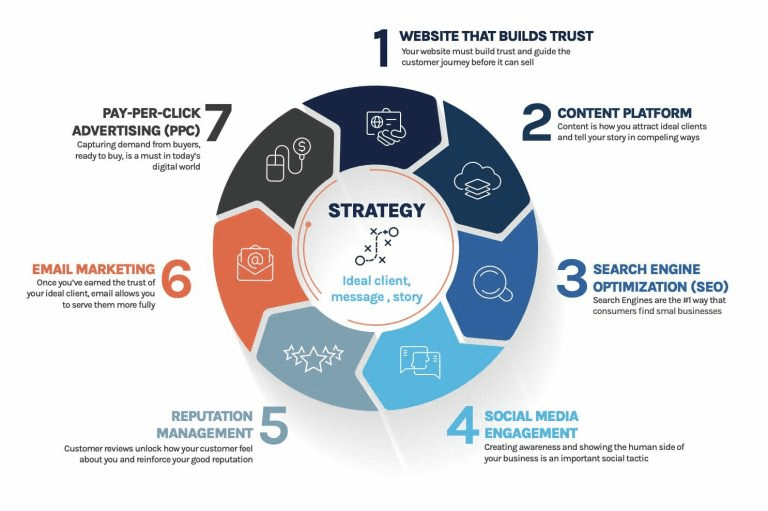How to write a winning lawn care business plan in 9 steps
GorillaDesk Staff

Finances and future planning are two major hurdles for starting a lawn care business—especially when you’re faced with slower winter months after the booming business of summer. A solid business plan can replace a financial feast-or-famine cycle with smooth growth, consistent revenue, and overall business success.
Learn how to create a lawn care business plan that acts as your GPS for running a flourishing lawn care company.
How to create a lawn care business plan
Creating a lawn care business plan doesn’t have to be rocket science, though you do want to think carefully about how truthfully you represent your business and its potential. After all, your business plan isn’t just a pitch for investors, it’s a guide for your future, too.
Here are nine steps to get you started on creating a helpful, thorough business plan:
Step 1: Introduce your business
Introducing your lawn care business provides context for potential investors and stakeholders. (Source)
Your lawn care business plan should start with a basic introduction of your company. Because this section—also called an executive summary—is also a sort of elevator pitch for potential investors, experts advise writing it last to ensure it accurately summarizes your key points.
These key points should include:
- Your lawn care business name, mission statement, and vision
- The types of services you focus on, such as residential lawn care or commercial lawn care
- Your business model
- A summary of all services you offer
- An overview of your target market and service areas
- A list of your main competitors
- Your competitive advantage or value proposition
- Your current financial status, future projections, and goals
- Your funding needs, if you have any
As Samantha Hendricks, a small business consultant, notes, your executive summary should be clear, comprehensive, and compelling. ”If a potential investor or stakeholder can’t understand from the executive summary how you make money, you have a problem,” Hendricks says.
Example company overview
Turf Titans is a residential lawn care company dedicated to providing high-quality, eco-friendly lawn maintenance services. Our mission is to create and maintain beautiful, healthy lawns while minimizing environmental impact. Our vision is to become the leading sustainable lawn care provider in our region.
Step 2: Identify your competition
By identifying your competitors, you show awareness of your current challenges. Analyzing your competitors’ strategies also helps you craft your own unique value proposition that can attract and convert customers.
This section should identify not only your primary competition but also each competitor’s strengths and weaknesses. You can then highlight how your lawn care business’s value proposition uses those strengths and weaknesses to your advantage.
How to find your lawn maintenance business competition
A SWOT analysis helps you identify competition and craft a business strategy that considers your opportunities and threats. (Source)
Not sure how to identify your primary competitors? These steps can help you discover and analyze other companies operating in your target market.
- Do online research
Search Google, social media, and review sites to identify other lawn care companies in your area. Local business listings and social media profiles are an easy way to identify your competitors, while websites can give you an idea of their pricing strategies, service offerings, and selling strategies.
- Use local resources
Along with online searches, check your chamber of commerce’s local business directories to spot competing lawn care services. If your local area hosts business networking events, these are another opportunity to meet other lawn care professionals and gather insights about their businesses.
- Conduct a SWOT analysis
A strengths, weaknesses, opportunities, threats (SWOT) analysis helps you further identify potential opportunities for your unique value proposition and service offerings by prompting you to think about the following and related questions:
- Strengths: What do your competitors do well?
- Weaknesses: Where do your competitors fall short?
- Opportunities: What gaps exist in your local market that you can target?
- Threats: What external factors could impact your business?
A SWOT analysis can feel overwhelming since there are likely dozens of factors that impact your business. Business management consultant Edward Zeimis recommends “starting with a single key strength or opportunity,” then “focusing on factors that impact your business today.”
Example SWOT analysis
Turf Titans’ primary competitors include GreenLawn Pro, Nature’s Touch Landscaping, and Yard Masters:
GreenLawn Pro is a well-established lawn care company with over 15 years of market presence, boasting a large equipment fleet and strong commercial client relationships. However, its high prices and slow adoption of eco-friendly practices may be an opportunity for Turf Titans to expand into their market.
Nature’s Touch Landscaping distinguishes itself through artistic, custom landscape designs and expertise in native plant species. This has gained it strong word-of-mouth referrals and long-lasting customer loyalty. However, its focus on high-end clients, while profitable, limits its customer base and makes it vulnerable to economic downturns. This presents an opportunity for Turf Titans to expand into the Nature’s Touch market by offering maintenance services and sustainable gardening workshops.
Yard Masters competes primarily on price and quick response times, offering a wide range of basic lawn care services. It has a strong local marketing presence, but struggles with high employee turnover and inconsistent service quality. This presents an opportunity for Turf Titans to offer high-quality customer care and lawn care services offered by trusted experts in order to gain part of Yard Master’s market share.
Step 3: Research your market
Along with a thorough competitor analysis, your lawn service business plan should include a market analysis. (Source)
A market analysis identifies the types of local customers who might use your services and any opportunities for your lawn care company.
Your market analysis should include details like the following:
- The types of customers you’re targeting, such as property managers or homeowners
- How many potential customers are in your target market
- Your ideal customers’ demographics, such as age, income level, and family status
- Your ideal customers’ pain points and how your business can address them
- The price your target customers are willing to pay for your services
- The qualities your ideal customers look for in a lawn care service provider, such as customer service, price, or speed
Your market analysis should also include industry projections and other factors that could influence your ideal customers’ willingness to pay for services or the potential growth and decline of your target market. The good news is that experts expect the lawn care industry to grow at a compound annual growth rate of 5.2% from 2024 to 2029, meaning your lawn care business is more likely to see growth as well.
Example market analysis
Turf Titans’ ideal customers match the following demographics:
- Residential homeowners residing in Meadowbrook or surrounding suburbs
- Household income of $75,000 to $200,000 annually
- Working professionals ages 35 to 65 years old
- Own single-family homes, townhomes, or duplexes with lawns or small yards
Step 4: List your lawn care services
List the lawn services you offer. You should also cover any related services, like tree trimming, mulching, and weed control.
For example, Lawn and Landscape magazine’s 2024 State of the Industry report found that 86% of lawn care businesses also offer lawn care and chemical application, such as aeration and fertilization services, while 71% also offer lawn care services. A majority of lawn care businesses (90%) also offer related services like seasonal cleanup, snow removal, and pest control services.
Example lawn care services statement
Turf Titans operates on a subscription-based model, offering weekly, bi-weekly, and monthly service packages. We also provide one-time services for urgent lawn care needs. Our eco-friendly approach includes using electric equipment and organic fertilizers.
Turf TItans specializes in comprehensive lawn care services, including:
- Lawn mowing and edging
- Fertilization and weed control
- Aeration and overseeding
- Seasonal clean-up
Step 5: Explain your pricing strategies
Break down how you’ve priced each service and bundle in a comprehensive lawn care pricing chart.
When pricing your services, be sure to factor in labor costs and expenses like your business license, equipment such as blowers and trimmers, and lawn care business insurance. This helps you identify ideal prices for reaching your target profit margin. If breaking it all down feels overwhelming, using resources such as pay someone to write my research paper can offer a structured approach to creating financial projections and understanding your market better.
Example lawn care pricing chart
Turf Titans balances high-quality lawn care and an eco-friendly approach with value-driven prices:
- Hourly rate: $50
- Lawn size (in acres): 0.25
- Mowing (1 hour): $50
- Aeration (3 hours): $150
- Overseeding (1.5 hours): $75
- Leaf removal (1.5 hours): $75
- Fertilizing (0.5 hours): $25
- Weed control (1 hour): $50
- Seasonal yard cleanup (1 hour): $50
Step 6: Create a marketing and sales strategy
Your lawn care marketing plan can target a variety of different channels to attract new customers. (Source)
If you don’t already have a marketing plan for your lawn care company, now’s the time to create one. Skipping this step can leave you without clear directions for attracting new customers and retaining existing ones.
Your marketing strategy should explain how you’ll attract and retain customers and include these details:
- How you’ll gather new leads through your lawn care website and blog
- Which marketing channels you use, such as social media, email marketing, and direct mail
- How your pricing strategy meets customer needs
- How you’ll acquire new lawn care leads through word-of-mouth referrals or online reviews
- How you’ll retain existing customers
- Your sales and marketing forecasts and goals
Don’t skip local search: Learn how to use local search engine optimization to get your business website to show up when customers search for “lawn care near me.”
Example marketing strategy
Turf Titans aims to establish a strong presence in Meadowbrook and build long-lasting relationships to drive business and grow customer loyalty through the following existing marketing strategies:
- Facebook, Instagram, and NextDoor posts
- Monthly email newsletters
- Actively managing business profiles on Google My Business, Yelp, and Facebook
- Optimizing business profiles for Google Local Services ads and Maps
- The Turf Titans website and blog
- Local partnerships with Meadowbrook garden centers and hardware stores
Additionally, Turf Titans plans to add the following marketing strategies within the next year:
- A referral program that offers existing customers a 10% discount on their next service
- Direct mail postcards sent to neighborhoods with a high concentration of ideal customers
Step 7: Describe how you run your business
Lawn care software like GorillaDesk improves your business’s operational efficiency. (Source)
Give stakeholders and potential investors a peek into how you run your business on a day-to-day basis. Doing this shows how efficiently your company operates.
Be sure to cover the following details:
- Your current lawn care equipment and supply needs
- Your processes for scheduling, routing, and completing services
- Current employees, plus projected full-time and seasonal staffing needs
You can also mention any technology, like lawn care business software, you use to streamline processes like scheduling, billing, and customer communications.
Example operational overview
Turf Titans currently maintains a fleet of eco-friendly equipment:
- 10 electric riding mowers
- 15 electric push mowers
- 20 electric trimmers and edgers
- 5 electric leaf blowers
- 3 vehicles for transporting equipment and supplies
Our supply inventory includes:
- Organic fertilizers and pest control products
- Grass seed mixtures suitable for Meadowbrook’s climate
- Eco-friendly weed control solutions
Our current office staff includes:
- General Manager: Sarah Chen
- Operations Manager: Michael O’Brien
- Customer Service Representative: Alicia Rodriguez
- Marketing Coordinator: Earl Wyatt
Our current full-time lawn care technicians include:
- Team Lead: Marcus Johnson
- Specialists: Marcus Johnson, Carlos Fernandez, Emily Watson, Amir Patel, Olivia Nguyen, Derek Thompson, Samantha Lee, and Robert Jackson
Step 8: Document your financial plan
Your financial plan is a comprehensive look at your current and historical finances, along with financial projections. This outlook reassures stakeholders and investors that your business can turn a profit.
Your financial plan should detail the following:
- Any startup costs
- Your revenue and expense projections for the next three to five years
- Cash flow statements
- A break-even analysis
- Any funding requirements and how you’ll use those funds
Successful lawn care businesses use their financial plan to overcome economic downturns, disruptive technologies, and other external challenges.
Example financial plan
Turf Titans has operated for three years, achieving profitability in its second year. Current annual revenue is $480,000, with a net profit margin of 12%. We project 20% year-over-year growth for the next three years, targeting annual revenue of $830,000 by year six.
Turf Titans’ current business goals include:
- Expand our service area to cover the entire Meadowbrook metro and suburbs within a 60-mile radius within two years
- Increase our market share by 10%
- Improve our customer retention rate by 20%
To support our growth plans, Turf Titans is seeking $500,000 in funding. We’ll use this capital to:
- Purchase additional eco-friendly equipment ($200,000)
- Expand our marketing efforts ($150,000)
- Hire and train additional staff ($150,000)
This investment enables Turf Titans to capitalize on the growing demand for sustainable lawn care services and achieve our ambitious market growth targets.
Step 9: Grow your team
You’ll also want to document how you’ll grow your team to support future goals and growth. This should include not only the roles you hope to fill over the next dozen months or so, but also how you’ll train and strengthen your existing team’s skills.
Be sure to break down the following details within your staff planning section:
- How many employees you’ll need in the future and which roles they’ll fill
- Current and projected employee wages
- Your current average number of jobs per day
- How much revenue you currently need to make per job to cover costs
- Projected average number of jobs per day and revenue per job needed to cover costs
Even if you’re a solo employee, it’s important to fill out the employee planning section to ensure you can still cut yourself a paycheck while growing your business.
Example employee plan
Turf Titans’ projected staffing needs for the next two years include:
- Two additional customer service representatives
- One HR coordinator
- Eight additional full-time lawn care specialists
- One additional lawn care team lead
- One equipment maintenance technician
5 tips for writing a lawn care business plan for future success
When you sit down to write your lawn mowing business plan, keep these tips in mind to put your best foot forward with stakeholders and investors:
- Create a professional, well-organized document or use a lawn care business plan template.
- Stay realistic when writing down your goals.
- Detail what you’ll need to grow your business over time.
- Regularly update your plan as your business grows.
- Ask someone to review your business plan and provide feedback; many business consulting firms offer this service.
As Ray Drew, the small business administration managing director at Truliant Federal Credit Union, writes, “The exercise of creating a business plan and projections isn’t just to get a loan. It’s to figure out if your idea is viable.”
The top 3 challenges when starting a lawn care business
Starting a new business can feel like running an obstacle course blindfolded. But your business plan helps you carefully plan your steps to avoid hazards. And if worse comes to worst, your business plan helps you overcome the following common challenges:
1. Setting unrealistic expectations
Keeping your expectations grounded in reality is best. Many new business owners tend to overestimate their potential and run into the following mistakes:
- Misjudging how many lawns you can service in a day or week
- Believing you can offer only lawn mowing services instead of supplementing your revenue with related services
- Expecting to easily find and hire experienced technicians; a survey by Irrigation & Lighting magazine found that 72% of lawn care businesses said labor availability and retention was their top barrier to business growth
- Setting overly optimistic revenue and growth goals
If you’re not confident that your projections and goals are realistic, have a consultant or friend check your business plan.
2. Making costly financial mistakes
Staying cautious while funding your new business is key. Borrowing too much can significantly impact your future financial health, due to the interest on loans. Lender platforms, such as Bryt Software, help borrowers stay on track with clear repayment schedules and transparent loan management.
Other potential financial missteps to watch out for include:
- Underpricing your services
- Not budgeting for necessary equipment
- Spending too much money on unnecessary equipment
- Stalling cash flow by not following up with customers on late payments or not sending out lawn care invoices on time
It’s also important to keep detailed records of all your business expenses. This helps you understand the true cost of running your business—and it’s also helpful when tax season rolls around.
3. Running an inefficient business
Using lawn care apps like GorillaDesk helps you efficiently manage your business, even while you’re in the field. (Source)
Passion may have lit a fire under you to start your lawn care business, but you can’t simply focus on mowing lawns and pruning shrubs. Your business needs you (or someone else) to tackle administrative tasks as well.
Similarly, you may find yourself answering the phone or responding to online reviews. While this may seem less important than getting your hands dirty, it’s critical for building a positive business reputation that attracts customers.
One way to improve your business efficiency without having to hire new team members is to use lawn care apps. Using a tool like GorillaDesk’s mobile app makes it easy to stay on top of customer communications and tackle administrative tasks like sending estimates and invoices—even while you’re in the field.
Improve business efficiency and success with GorillaDesk
PurLawn owners Matt and Evan use GorillaDesk to run a successful, efficient lawn care business. (Source)
Your lawn care business plan acts as a guide for navigating slow seasons and jumping on new opportunities. Regularly updating this living document ensures that you always have a winning play in your back pocket.
Including GorillaDesk’s lawn care business software in your game plan is one way to tip the odds in your favor. Florida lawn care business PurLawn added GorillaDesk to its lineup, resulting in cost savings and less chaos.
“[GorillaDesk] just felt right, user-friendly, cost-effective, [and] intuitive,” PurLawn co-owner Matt said.
Give GorillaDesk a try with a 14-day free trial to see how it can help you reach your lawn care business goals.
Other posts to check out
Make the move from paper to digital: A step-by-step guide for field service pros
If your field service business is still doing business on paper, it’s time to make a change. Here’s how to find success with a move to digital.
Pest control marketing: Let’s make that phone ring
With so many other local pest control companies making competition tight, keeping that phone ringing with new customers may not feel as easy as you thought. To keep your pest control business growing takes marketing know-how. Here are our best tips.
How to get more positive customer feedback
Customers trust online reviews just as much as word of mouth from friends and family. The truth is: Online reviews can make or break your local services business. Here’s how to build that glowing reputation your service deserves.
Tree service marketing: 11+ ideas to drive more customers in 2025
Drive more leads with our ultimate tree service marketing guide! Discover 11+ proven strategies to grow your business and attract the right customers.
How to start a tree service business in 2025
Learn how to start a tree service business with step-by-step guidance on planning, licensing, equipment, marketing, safety, and scaling your company.
Landscaping services list: What to offer your customers
Discover the top landscaping services to offer for maximum profit. From design to maintenance, expand your business with our comprehensive landscaping services list.
Transform your business
Try it free for 14 days. No credit card required. Instant setup.
★★★★★
We will be customers for life
“I can not say enough good things about GorillaDesk it saves us so much time and money. The customer service is the best. I would recommend GorillaDesk to anyone no matter what industry. I trained my employee in 5 minutes on how to use it. We will be customers for life.”

Ryan Sullivan
Business Owner
Ready to Get Started?
Get all our amazing features and top-rated support, with no credit card required.













